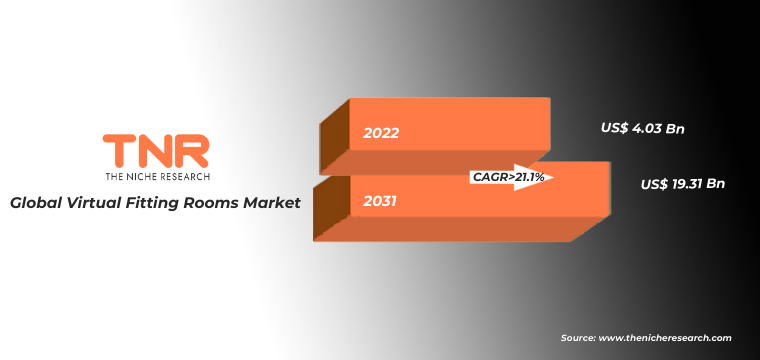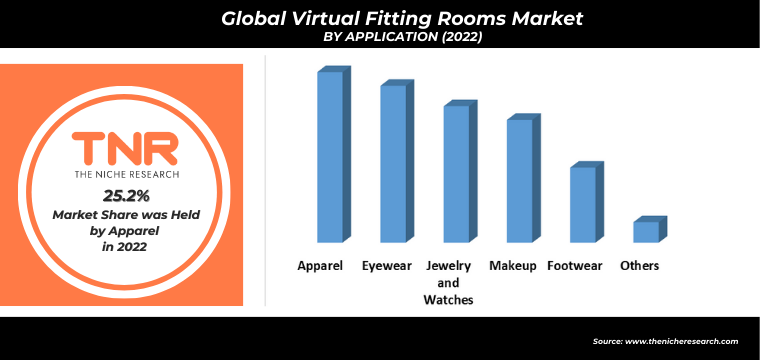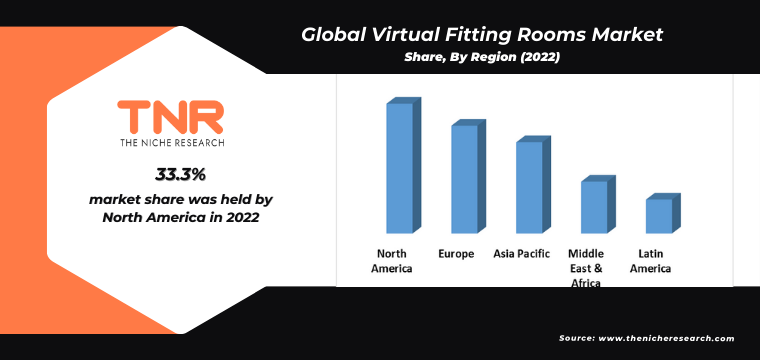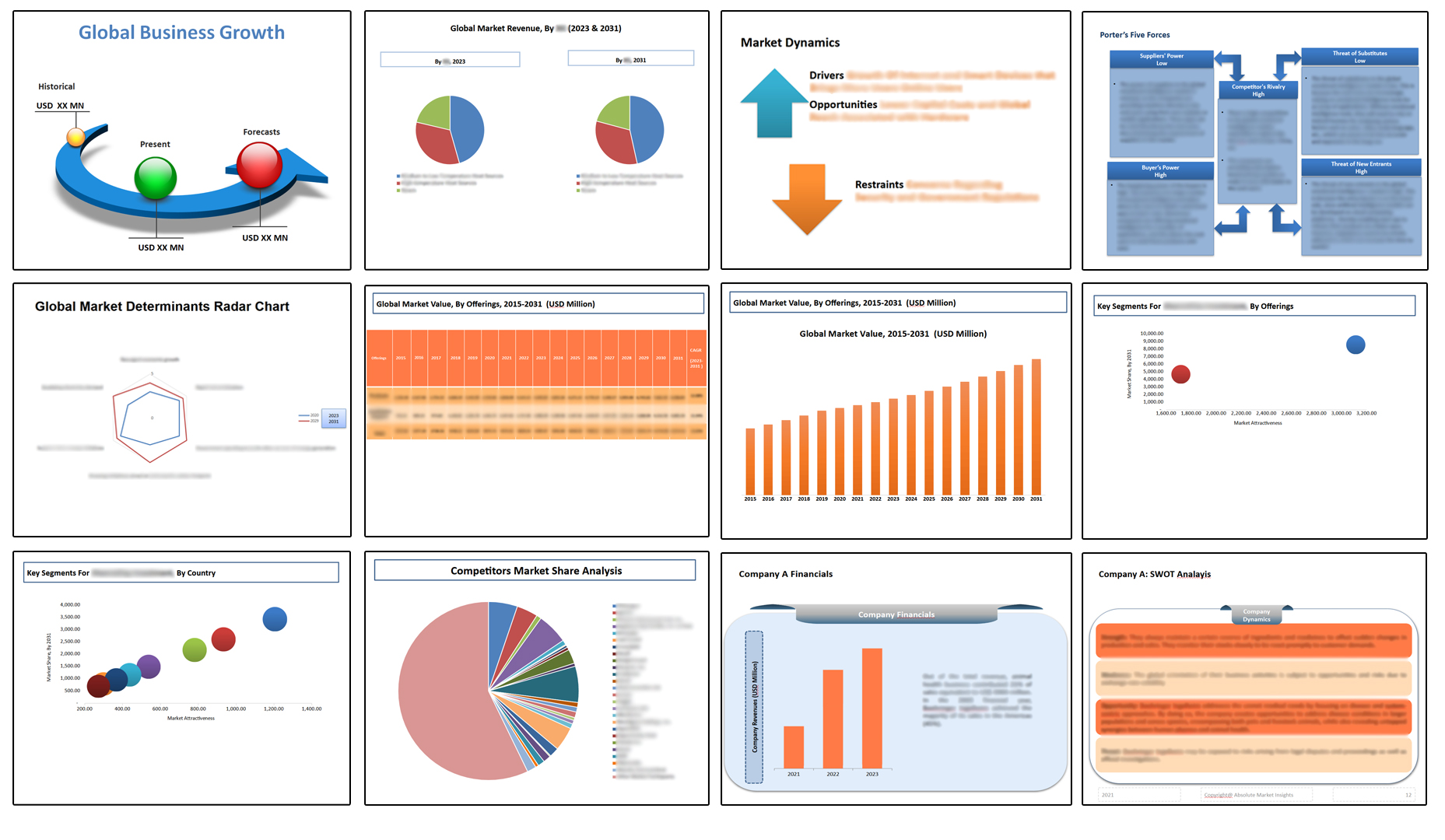Global Virtual Fitting Rooms Market Insights, Growth, Share, Size: By Offerings, By Application, By End Users, By Region & Segmental Forecast, 2023-2031, Comparative Analysis and Trends
- Industry: Technology
- Report ID: TNR-110-1004
- Number of Pages: 420
- Table/Charts : Yes
- November, 2023
- Base Year : 2024
- No. of Companies : 14+
- No. of Countries : 29
- Views : 10199
- Covid Impact Covered: Yes
- War Impact Covered: Yes
- Formats : PDF, Excel, PPT
Global Virtual Fitting Rooms Market was Valued USD 4.03 Bn in 2022, with estimated CAGR of 21.1% (2023-2031).
A virtual fitting room is a digital counterpart of an in-store dressing room in which buyers may digitally try on a product to see how it will appear on their bodies and assess elements such as colour, pattern, and style before purchase. There are several virtual try-on alternatives available today. These are frequently based on a mix of artificial intelligence, computer vision, and augmented reality.
Innovative scaling solutions have emerged as a result of the rapid technology improvements during the last decade. In addition to addressing consumer size concerns, these solutions are assisting brands in meeting inclusiveness and sustainability goals while generating increased business performance.
Global Virtual Fitting Rooms Market Revenue & Forecast, (US$ Million), 2015 – 2031

Factors Supporting the Growth of the Global Virtual Fitting Rooms Market
The ever-increasing amount of returns is one of the most serious issues confronting fashion merchants. According to Shopify, 30% of all eCommerce returns are due to the goods being too small in size, while another 22% are due to customers buying an item in an incorrect size. By offering an online trial room for clothing, retail establishments may help to solve the problem of bad fit. Virtual fitting technology may help organizations gain data about their customers and the items they buy, but it can also help brands drive conversions.
Virtual fitting rooms, such as 3DLOOK’s YourFit, provide merchants with a wealth of anonymised data by using body scanning technology to retrieve each customer’s unique body measurements. Retailers may use this information to fine-tune their dragging rules, increase distribution, customize marketing efforts, and create future items according on the requirements and tastes of their most loyal consumers.
Furthermore Covid-19 pandemic has positively impacted the global virtual fitting rooms market. In response to increasing concerns over Covid-19 variations, merchants have implemented numerous safety precautions in most brick-and-mortar stores and are considering tech-driven dressing to quickly replace the fitting room experience, which was formerly the key selling feature of in-person businesses.

Virtual fitting rooms have received a lot of interest in the apparel industry because of their potential to change the way people shop for clothes online. According to the survey, the three largest potential for fashion firms are digital, sustainability, and customer involvement, which represent the demands of millennial consumers. Retailers are looking forward to achieve all of these demands by implementing 3D virtual fitting room software. According to my company’s internal research, merchants have witnessed an increase in average order value of more than 23% when using AI-powered style. Fashion businesses can leverage vast amount of client data with virtual changing rooms, allowing them to better understand their customers.

North America had the highest share in the virtual fitting rooms market in 2022. As online shopping has become more common, consumers’ expectations have evolved. They seek experiences that replicate or even improve upon the traditional in-store shopping experience. Several U.S.-based retailers and tech companies have been early adopters of virtual fitting room technology. As online shopping has become more common, consumers’ expectations have evolved. They seek experiences that replicate or even improve upon the traditional in-store shopping experience. Virtual fitting rooms aim to bridge this gap by allowing customers to virtually try on clothing, leading to higher customer satisfaction and fewer returns due to improper fit.
Competitive Landscape
The report offers extensive research on the key players in this global virtual fitting rooms market and details on the competitiveness of these players. Key business strategies such as mergers and acquisitions (M&A), affiliations, collaborations, and contracts adopted by these major market participants are also recognized and analyzed in the report. For each company, the report studies their global presence, competitors, service offerings and specification amongst others.
Key competitors in the global virtual fitting rooms market are
- 3DLOOK INC.
- AstraFit
- FXGear Inc
- Mad Street Den Inc. (Vue.ai)
- Magic Mirror
- Perfitly
- RoboSize LTD.
- SenseMi DMCC – VIUBOX
- Sizebay
- Style.me
- TEXEL
- triMirror
- True Fit Corporation
- VIRTUAL ON LTD
- Zugara, Inc
- Other Industry Participants
Global Virtual Fitting Rooms Market Report Coverage
| Report Specifications | Details |
| Market Revenue in 2022 | US$ 4.03 Billion |
| Market Size Forecast by 2031 | US$ 19.31 Billion |
| Growth Rate (CAGR) | 21.1% |
| Historic Data | 2015 – 2021 |
| Base Year for Estimation | 2022 |
| Forecast Period | 2023 – 2031 |
| Report Inclusions | Market Size & Estimates, Market Dynamics, Competitive Scenario, Trends, Growth Factors, Market Determinants, Key Investment Segmentation, Product/Service/Solutions Benchmarking |
| Segments Covered | By Offerings, By Application, By End Users |
| Regions Covered | North America, Europe, Asia Pacific, Middle East & Africa, Latin America |
| Countries Covered | U.S., Canada, Mexico, Rest of North America, France, The UK, Spain, Germany, Italy, Nordic Countries (Denmark, Finland, Iceland, Sweden, Norway), Benelux Union (Belgium, The Netherlands, Luxembourg), Rest of Europe, China, Japan, India, New Zealand, Australia, South Korea, Southeast Asia (Indonesia, Thailand, Malaysia, Singapore, Rest of Southeast Asia), Rest of Asia Pacific, Saudi Arabia, UAE, Egypt, Kuwait, South Africa, Rest of Middle East & Africa, Brazil, Argentina, Rest of Latin America |
| Key Players | 3DLOOK INC., AstraFit, FXGear Inc, Mad Street Den Inc. (Vue.ai), Magic Mirror, Perfitly, RoboSize LTD., SenseMi DMCC – VIUBOX, Sizebay, Style.me, TEXEL, triMirror, True Fit Corporation, VIRTUAL ON LTD, Zugara, Inc, Other Industry Participants |
| Customization Scope | Customization allows for the inclusion/modification of content pertaining to geographical regions, countries, and specific market segments. |
| Pricing & Procurement Options | Explore purchase options tailored to your specific research requirements |
| Contact Details | Consult With Our Expert
Japan (Toll-Free): – +81 663-386-8111 South Korea (Toll-Free): – +82-808- 703-126 Saudi Arabia (Toll-Free): – +966 800 850 1643 United States: +1 302-232-5106 United Kingdom: +447537105080 E-mail: askanexpert@thenicheresearch.com
|
Global Virtual Fitting Rooms Market
By Offerings
- Hardware
- Prefabricated
- Customized
- Software
- Integrated
- Standalone
- Services
By Application
- Apparel
- Eyewear
- Jewelry and Watches
- Makeup
- Footwear
- Others
By End Users
- Brick and Mortar Stores
- Virtual Stores
By Region
- North America (U.S., Canada, Mexico, Rest of North America)
- Europe (France, The UK, Spain, Germany, Italy, Nordic Countries (Denmark, Finland, Iceland, Sweden, Norway), Benelux Union (Belgium, The Netherlands, Luxembourg), Rest of Europe)
- Asia Pacific (China, Japan, India, New Zealand, Australia, South Korea, Southeast Asia (Indonesia, Thailand, Malaysia, Singapore, Rest of Southeast Asia), Rest of Asia Pacific)
- Middle East & Africa (Saudi Arabia, UAE, Egypt, Kuwait, South Africa, Rest of Middle East & Africa)
- Latin America (Brazil, Argentina, Rest of Latin America)
Report Coverage and Deliverables:

Table of Contents
Note: This ToC is tentative and can be changed according to the research study conducted during the course of report completion.
**Exclusive for Multi-User and Enterprise User.
Global Virtual Fitting Rooms Market Segmentation
Offerings
By Application
By End Users
By Region
**Note: The report covers cross-segmentation analysis by region further into countries
The Niche Research approach encompasses both primary and secondary research methods to provide comprehensive insights. While primary research is the cornerstone of our studies, we also incorporate secondary research sources such as company annual reports, premium industry databases, press releases, industry journals, and white papers.
Within our primary research, we actively engage with various industry stakeholders, conducting paid interviews and surveys. Our meticulous analysis extends to every market participant in major countries, allowing us to thoroughly examine their portfolios, calculate market shares, and segment revenues.
Our data collection primarily focuses on individual countries within our research scope, enabling us to estimate regional market sizes. Typically, we employ a bottom-up approach, meticulously tracking trends in different countries. We analyze growth drivers, constraints, technological innovations, and opportunities for each country, ultimately arriving at regional figures.Our process begins by examining the growth prospects of each country. Building upon these insights, we project growth and trends for the entire region. Finally, we utilize our proprietary model to refine estimations and forecasts.
Our data validation standards are integral to ensuring the reliability and accuracy of our research findings. Here’s a breakdown of our data validation processes and the stakeholders we engage with during our primary research:
- Supply Side Analysis: We initiate a supply side analysis by directly contacting market participants, through telephonic interviews and questionnaires containing both open-ended and close-ended questions. We gather information on their portfolios, segment revenues, developments, and growth strategies.
- Demand Side Analysis: To gain insights into adoption trends and consumer preferences, we reach out to target customers and users (non-vendors). This information forms a vital part of the qualitative analysis section of our reports, covering market dynamics, adoption trends, consumer behavior, spending patterns, and other related aspects.
- Consultant Insights: We tap into the expertise of our partner consultants from around the world to obtain their unique viewpoints and perspectives. Their insights contribute to a well-rounded understanding of the markets under investigation.
- In-House Validation: To ensure data accuracy and reliability, we conduct cross-validation of data points and information through our in-house team of consultants and utilize advanced data modeling tools for thorough verification.
The forecasts we provide are based on a comprehensive assessment of various factors, including:
- Market Trends and Past Performance (Last Five Years): We accurately analyze market trends and performance data from preceding five years to identify historical patterns and understand the market’s evolution.
- Historical Performance and Growth of Market Participants: We assess the historical performance and growth trajectories of key market participants. This analysis provides insights into the competitive landscape and individual company strategies.
- Market Determinants Impact Analysis (Next Eight Years): We conduct a rigorous analysis of the factors that are projected to influence the market over the next eight years. This includes assessing both internal and external determinants that can shape market dynamics.
- Drivers and Challenges for the Forecast Period:Identify the factors expected to drive market growth during the forecast period, as well as the challenges that the industry may face. This analysis aids in deriving an accurate growth rate projection.
- New Acquisitions, Collaborations, or Partnerships: We keep a close watch on any new acquisitions, collaborations, or partnerships within the industry. These developments can have a significant impact on market dynamics and competitiveness.
- Macro and Micro Factors Analysis:A thorough examination of both macro-level factors (e.g., economic trends, regulatory changes) and micro-level factors (e.g., technological advancements, consumer preferences) that may influence the market during the forecast period.
- End-User Sentiment Analysis: To understand the market from the end-user perspective, we conduct sentiment analysis. This involves assessing the sentiment, preferences, and feedback of the end-users, which can provide valuable insights into market trends.
- Perspective of Primary Participants: Insights gathered directly from primary research participants play a crucial role in shaping our forecasts. Their perspectives and experiences provide valuable qualitative data.
- Year-on-Year Growth Trend: We utilize a year-on-year growth trend based on historical market growth and expected future trends. This helps in formulating our growth projections, aligning them with the market’s historical performance.
Research process adopted by TNR involves multiple stages, including data collection, validation, quality checks, and presentation. It’s crucial that the data and information we provide add value to your existing market understanding and expertise. We have also established partnerships with business consulting, research, and survey organizations across regions and globally to collaborate on regional analysis and data validation, ensuring the highest level of accuracy and reliability in our reports.









